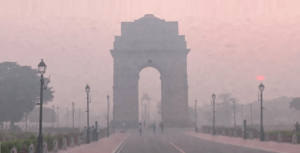Delhi Chokes: Diwali Revelry Turns Capital into World’s Most Polluted City (AQI 348)
On Friday, New Delhi was reported as the world’s most polluted city, with the air quality index reaching 348, which falls into the hazardous category, according to Swiss firm IQ Air. The spike in pollution levels was attributed to revelers ignoring a firecracker ban during Diwali celebrations. The capital was enveloped in thick smog, obscuring the presidential palace and nearby gardens commonly frequented by joggers and cyclists, following the festivities held on Thursday.
CONTENTS:

Delhi Chokes: Diwali Revelry Turns Capital into World’s Most Polluted City (AQI 348)
Delhi air quality improves post-Diwali
Delhi Chokes: Diwali Revelry Turns Capital Following a peak Air Quality Index (AQI) of 362 on Friday, Delhi’s air quality has begun to improve. Environment Minister Gopal Rai noted that pollution levels remained manageable during Diwali, as most residents chose to celebrate with lamps rather than firecrackers, although some areas did see fireworks. Rai expressed optimism that those who used firecrackers this year would reconsider for next Diwali, highlighting a shift in public attitudes towards pollution control.
Rai stated, “The people of Delhi have managed to reduce pollution levels after Diwali. The limited use of firecrackers shows a changing mindset. While celebrating is important, it’s equally crucial to protect public health.” He also pointed out that Friday’s air quality was better than anticipated.
Data from the Central Pollution Control Board (CPCB) indicated that Delhi’s AQI remained at 327 between 6 PM and 9 PM on Thursday, then gradually increased, peaking at 362 (very poor) at 9 AM on Friday before slowly declining throughout the day. On Diwali itself, the average AQI was 328, classified as very poor.
An official from the India Meteorological Department attributed the improvement in air quality post-Diwali to strong winds and warmer temperatures for this time of year. Wind speeds reached 12-16 km/hr until Thursday evening, which helped disperse pollutants. Rai acknowledged that the AQI had recently been in the very poor category and stressed the need for immediate action to prevent pollution from reaching severe levels, announcing a citywide initiative for water sprinkling to help control pollution.
Forecasts from the Centre’s Early Warning System for Delhi had anticipated very poor air quality post-Diwali, warning that it could worsen to severe if additional emissions occurred from firecrackers or stubble burning.
Delhi Chokes: Diwali Revelry Turns Capital In response, BJP leader and south Delhi MP Ramvir Singh Bidhuri criticized the Aam Aadmi Party (AAP) government for misrepresenting the sources of pollution. He argued that local pollution sources, like dust and vehicular emissions, were primarily to blame, rather than the temporary use of firecrackers. He claimed that the government’s failure to address issues like road conditions, public transport shortages, and open waste burning was exacerbating air quality problems.
He stated, “The roads are in disrepair, leading to increased dust pollution, and there is a significant shortage of buses, forcing residents to rely on personal vehicles.” He criticized the AAP government for being politically focused rather than addressing the persistent air quality issues that have been affecting residents’ health for weeks.
This morning, air quality in Delhi deteriorated as residents ignored a firecracker ban during the Diwali celebrations on Thursday. The continuous use of firecrackers not only resulted in significant noise pollution but also enveloped the city in thick smoke, with many people disregarding the restrictions until late at night.
Real-time data from the System of Air Quality and Weather Forecasting and Research (SAFAR) showed that Delhi’s Air Quality Index (AQI) rose to 359 at 6:30 AM, categorizing it as “very poor.” On Diwali morning, the AQI was recorded at 328.
The AQI classifications are as follows: 0-50 is good, 51-100 satisfactory, 101-200 moderate, 201-300 poor, 301-400 very poor, 401-450 severe, and above 450 severe-plus. The levels of PM2.5, harmful fine particulate matter that can enter the bloodstream through the lungs, spiked to over 23 times the World Health Organization’s recommended daily limit.
Monitoring organization IQAir reported that pollutant levels exceeded 345 micrograms per cubic meter, ranking Delhi as the city with the worst air quality in the world. Most of the 40 monitoring stations in the city indicated “very poor” air quality, with Anand Vihar and RK Puram recording the highest AQI levels at 395, followed closely by Burari Crossing (394), Sonia Vihar (392), Punjabi Bagh (391), and several others.
The Indian Institute of Tropical Meteorology (IITM) in Pune has forecasted that air quality in Delhi will likely remain in the “very poor” category (AQI 300-400) on Friday.
In anticipation of the celebrations, Delhi Environment Minister Gopal Rai had announced the formation of 377 teams to enforce the firecracker ban throughout the capital. Additionally, a senior Delhi Police officer stated that all deputy commissioners of police (DCPs) were instructed to establish dedicated teams to prevent firecracker use in their districts.
Last year, during Diwali on November 12, Delhi experienced its best air quality in eight years, with an average AQI of 218. The rise in pollution levels in the capital is often attributed to stubble burning in neighboring Haryana and Punjab, particularly during the October-November post-harvest period. The city has been struggling with hazardous air quality for several weeks, leading authorities to implement stage two of the Graded Response Action Plan (GRAP) last week.
Delhi ranked world’s most polluted
Delhi Chokes: Diwali Revelry Turns Capital On Friday, New Delhi was reported as the world’s most polluted city, with the air quality index reaching 348, which falls into the hazardous category, according to Swiss firm IQ Air. The spike in pollution levels was attributed to revelers ignoring a firecracker ban during Diwali celebrations.
The capital was enveloped in thick smog, obscuring the presidential palace and nearby gardens commonly frequented by joggers and cyclists, following the festivities held on Thursday.
Check out TimesWordle.com for all the latest news
You must be logged in to post a comment.